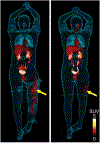Molecular imaging in oncology: Current impact and future directions
- PMID: 34902160
- PMCID: PMC9189244
- DOI: 10.3322/caac.21713
Molecular imaging in oncology: Current impact and future directions
Abstract
The authors define molecular imaging, according to the Society of Nuclear Medicine and Molecular Imaging, as the visualization, characterization, and measurement of biological processes at the molecular and cellular levels in humans and other living systems. Although practiced for many years clinically in nuclear medicine, expansion to other imaging modalities began roughly 25 years ago and has accelerated since. That acceleration derives from the continual appearance of new and highly relevant animal models of human disease, increasingly sensitive imaging devices, high-throughput methods to discover and optimize affinity agents to key cellular targets, new ways to manipulate genetic material, and expanded use of cloud computing. Greater interest by scientists in allied fields, such as chemistry, biomedical engineering, and immunology, as well as increased attention by the pharmaceutical industry, have likewise contributed to the boom in activity in recent years. Whereas researchers and clinicians have applied molecular imaging to a variety of physiologic processes and disease states, here, the authors focus on oncology, arguably where it has made its greatest impact. The main purpose of imaging in oncology is early detection to enable interception if not prevention of full-blown disease, such as the appearance of metastases. Because biochemical changes occur before changes in anatomy, molecular imaging-particularly when combined with liquid biopsy for screening purposes-promises especially early localization of disease for optimum management. Here, the authors introduce the ways and indications in which molecular imaging can be undertaken, the tools used and under development, and near-term challenges and opportunities in oncology.
Keywords: magnetic resonance imaging (MRI); nuclear medicine; optical imaging; positron emission tomography (PET); single-photon emission computed tomography (SPECT); theranostics.
© 2021 The Authors. CA: A Cancer Journal for Clinicians published by Wiley Periodicals LLC on behalf of American Cancer Society.
Figures








References
-
- About nuclear medicine and molecular imaging. Available at: https://www.snmmi.org/AboutSNMMI/Content.aspx?ItemNumber=6433. Last accessed: March 13, 2021.
-
- Anderson CJ, Lewis JS. Current status and future challenges for molecular imaging. Philos Trans A Math Phys Eng Sci. 2017; 375: 20170023. - PubMed
Publication types
MeSH terms
Grants and funding
LinkOut - more resources
Full Text Sources
Other Literature Sources

